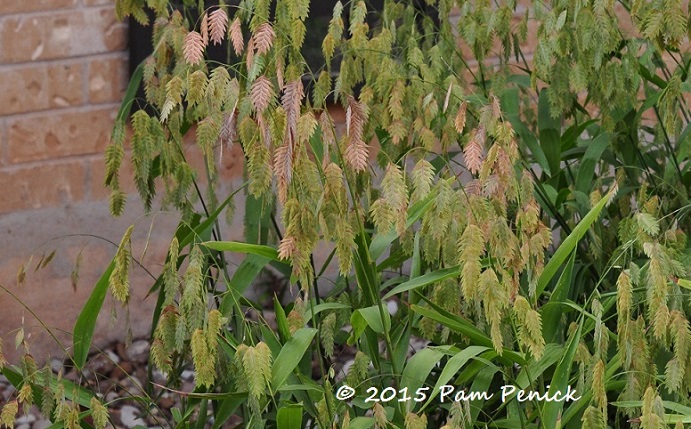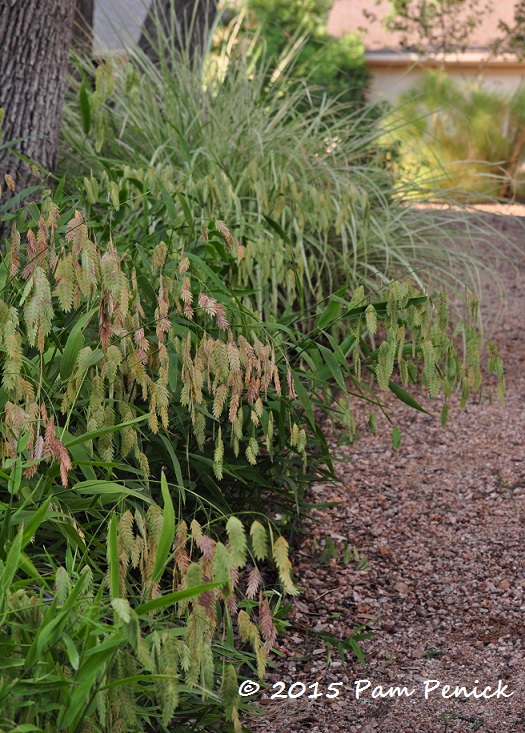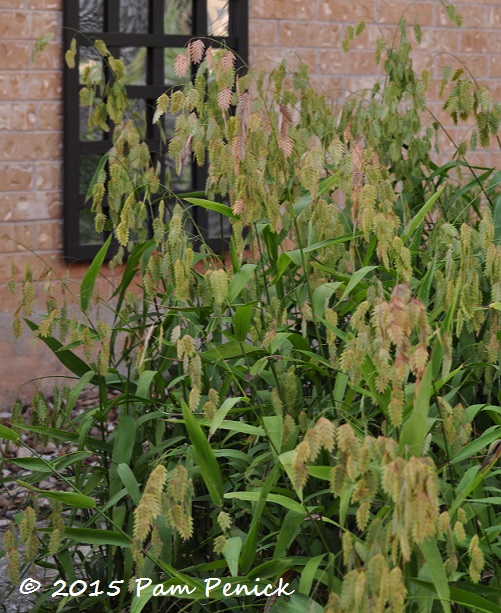Plant This: Inland sea oats
Are you hunting for a shade plant that looks good from April to January but especially shines during the challenging late summer? Try inland sea oats, also known as northern sea oats (Chasmanthium latifolium), a grass that’s native to eastern and central North America, including central Texas. A riparian species — you’ll see it growing wild along creeks in Austin’s greenbelts — it’s marketed as a good choice for rain gardens. But with plenty of shade it grows just as well in the dry soil under live oaks.
This is the time of year I love inland sea oats the best — and there aren’t a lot of plants I can say that about. The oat-like seedheads, which to me resemble fish dangling from a line, begin changing from early summer’s apple green to fall’s bleached tan in late August and early September. The mix of soft colors is pleasing and adds interest to the late-summer garden, plus it’s a welcome promise that fall is on the way!
Inland sea oats grows in clumps, with erect but nodding stems that stand between 2 and 4 feet tall, depending on how much water it gets. Mine stays at about 2 feet under the live oaks, with once-a-week watering. It seeds out aggressively in moist conditions and can quickly form a spreading colony. This can be good or bad, depending on your goals; just be aware and be prepared. Seeds that fall into gravel (dry creeks or paving) will likely sprout in the spring, so plan on weeding to keep it in bounds. That said, seedlings pull easily after a rain, and once you have the spring volunteers weeded out, you’re good to go all year, as this plant does not spread by runners.
By January or February, inland sea oats will be done. Whack it to the ground around Valentine’s Day to clear out the freeze-dried stems and make way for the first green leaves of spring. Or, if you cut it back earlier, in the fall, you can use the stems and seedheads in dried arrangements — but then you’ll lose the quiet winter beauty of rustling, dried grasses. Plan to leave some of them standing for cover for wildlife and winter interest.
With its graceful habit and vaguely bamboo-looking stems, it’s especially nice in an Asian garden. But I love it as a dry-shade filler that deer won’t touch. Try pairing it with our native Turk’s cap (Malvaviscus arboreus var. drummondii) and American beautyberry (Callicarpa americana) for a shade-loving, wildlife-friendly power trio that provides plenty of fall color.
Note: My Plant This posts are written primarily for gardeners in central Texas. The plants I recommend are ones I’ve grown myself and have direct experience with. I wish I could provide more information about how these plants might perform in other parts of the country, but gardening knowledge is local. Consider checking your local online gardening forums to see if a particular plant might work in your region.
All material © 2006-2015 by Pam Penick for Digging. Unauthorized reproduction prohibited.





I want to go on record: this is a plant that does equally well in Portland OR, zone 7ish. I second everything you have to say about it, save that it grows a bit taller here. I love it and dig up some to share every time we have a swap.
It’s also easy to share seeds after the seedheads ripen and turn brown in the fall. But I do always let fellow gardeners know how aggressive it can be, just in case they hate weeding. 😉 —Pam
Thanks – I didn’t know that sea oats is a shade plant. Mine is burning up in the sun so I will have to relocate it. Appreciate the info!
I bet it will be much happier in shade, Lise. It can take more sun if it gets a lot of water, but few of us have the luxury of that anymore, at least not in central Texas. —Pam
Love it also, especially the pattern of the seedhead and how easily it grows. It is easy to weed out – when young or dig up and plant elsewhere or give away, and it works in all kinds of soils, moisture, and light. And it does add movement to the garden as do all grasses.
You’ve said it, Marilyn. It’s a versatile plant. I wouldn’t put it near a moist area unless I wanted TONS of it. But I do love it for dry shade, which helps keep it contained. —Pam
Funny story – the scenario : the first time my garden was being photographed for a big, important magazine. Me: nervous and flustered, thinking “I’m not worthy”. The photographer – a lovely woman (she later became a good friend and did half of the photos for my book), obviously thinking “this lady is a freak. She needs help”.
The lovely photographer thought she would pitch in and weed a particularly “messy” part of my garden. The shot was lovely – a view of agaves and aloes and lavender, moving up to a climbing rose on my arbor. It was a portrait of me, so I was putting on make-up. I walked out to find the photographer on her hands and knees, weeding out the last bit of what was formerly a luxurious patch of Chasmanthium latifolium out of the frame. She looked so proud. I stifled a sob. My friend came up behind me and saw my face, saw the detritus, and said, in a low voice – oh no. Not the sea oats. Not the SEA OATS!
Not the SEA OATS!! I can just hear it echoing in your head and your heart. Oh dear. Beauty is, as ever, in the eye of the beholder. But I’m glad you’re on the side of the sea oats too, Ivette. Thanks for stopping by. 🙂 —Pam
Pam, how well does it compete with (other) weeds and volunteers in shade?
Pretty well, Peter, although it took a little while. This patch in my side garden took three years to fully fill in. I planted it from 4-inch pots, so they were small, and this is a dry, neglected area. I wanted them to hide the live oak sprouts that my garden is plagued with, and they now do a good job of that. The second year, Johnson grass or some other weedy grass snuck in there and tried to take hold, but I caught it in time and weeded it out. This year I saw no signs of that, and the sea oats have massed nicely. They definitely enjoyed all that rain in the spring. —Pam
You describe this plant quite well. I love the way it just keeps on growing and looking good through drought or rainy spells.
Yes, exactly, Lisa. So do I. —Pam
Could your use the sea oats as edible oats? They sure look good. I’ve been considering a winter wheat or some grain crop.
I have no idea, Brian. Don’t try it on your cereal without finding out first though. 😉 —Pam
Sorry, I’m a dissenter on this plant. I just couldn’t keep it under control. I love it. It looks great. Just in someone else’s garden.
Don’t feel bad, Chris. I recommended it for my in-laws, and they hated it for the same reason. It is definitely a plant to consider carefully. —Pam
This spring I found a variegated version at Joshua’s Native Plants here in Houston! It’s sitting in our north-facing courtyard and seems to be holding on… for the time being…
http://neilsperry.com/2011/08/plant-of-the-month-august-2011/
Wonderful plant! Versatile and fills up spaces with little to no care… what a trooper of a plant!
I bought ‘River Mist’ variegated sea oats from the Plant Delights online catalog a few years ago. It’s very beautiful, and it survives, but it hasn’t thrived for me. It comes back every year but never grows any larger than about 8 inches wide or 12 inches tall. I keep hoping though! —Pam
I love this plant, and I never water it, and that is probably why it has not spread very much. I must get some of the variegated version.
I agree, Karen, that keeping this plant on the dry side prevents some spreading. Using wood mulch helps too. Of course it does make a wonderful understory plant if you’re wanting to encourage it.
See my comment about the variegated variety in my response to Kapila, above. —Pam
I’m of two minds on this plant! As soon as I read the headline subject I was thinking “I hope Pam warns people about it’s spreading habit!”. In my own garden I’ve transplanted it around and like the way it fills in spaces, but at the Warrior and Family Support Center gardens it has taken over whole beds and I now tell the volunteers to treat it like hackberry tree seedlings and take them out whenever they see them. You are right about them being easy to eliminate while small but don’t wait till they get too big or you’ll be doing a lot of tough digging!
Thanks for sharing your experience with it, Melody. I think it’s one of those love-it-or-hate-it plants, depending on whether it’s tried to take over your garden. Keeping it dry and well mulched with shredded wood mulch is the best defense against its aggressive tendency. But even so it will require you to weed, so one needs to be prepared for that. —Pam
Pam:If nurseries were as conscientious about mentioning both the advantages and drawbacks of various plants in differing settings, I think gardeners would be much happier campers overall. I can’t count the number of times I bought a stellar plant that turned into a nuisance some way that was fairly easy to avoid if I’d had better information.
That said, I can’t imagine the size of the plastic plant descriptor strips they’d have to use to give us the bigger picture. Asking staff can help, but not everybody is equally well informed or experienced. I suppose we all must take responsibility for adequate research ahead of any purchases, and your blog is a great place to start.
Perhaps you’ll need to re-tag this post as Inland Sea Oats:PSA!
We really should all research every plant we buy, but let’s be real, right? 🙂 I’m a big fan of inland sea oats myself, but I know that not everyone is. Hopefully, a newbie reading this will be able to determine, with all my warnings about weeding, whether or not this is a good plant for them. —Pam
Funny story about those “nuisance plants”. I have a loverly Thunbergia Grandiflora covering part of my fence. It’s very aggressive. At least once every 2 weeks I have to wack it back because it jumps my fence, scales the neighbor’s and heads right up the side of his house. Now unlike the sea oats it doesn’t spread. And thankfully it dies back every winter. But some folks would consider it a nuisance.
Having to trim it once every two weeks is a lot. But it sounds like you’ve come to an understanding with it. I think that’s the key right there. Some plants are more of a nuisance in one person’s garden than in another. And some people are willing to put up with a certain amount of aggressiveness for all the beauty it provides. Knowing yourself as a gardener — what maintenance you’re willing to provide, and how often — is maybe the most important part of deciding what plants to plant, right after knowing your climate. —Pam
Love this plant, but so do my dogs. They eat it regularly. They keep it trimmed to about a 4 inch height. I just have to enjoy it down along the Barton Creek greenbelt.
How funny, Sarah! My dog never eats sea oats, but he loves to nibble bamboo muhly. Dogs! —Pam
Much easier than cutting them back: if you can wait (usually mid-late Feb.) until a few stems start to naturally break & fall over, it’s less work to just rake them up. They’ll easily break at a node near ground level and fall over when raked. They’re great for dry shade & sand here in DFW.
Good tip, Jan! —Pam
Is there a time of year that is best for planting inland sea oats? I’m located in central Oklahoma.
For planting seeds — and it grows readily from seed — I’d say early fall, since that’s when they’re fully ripened on the plant. You should have good results from planting actual plants in fall or spring. Just keep in mind that it goes dormant in winter, so don’t be alarmed if you plant in fall and it appears to die. Just give it regular water to get it established. Once established, it’s fairly drought tolerant in shade. —Pam